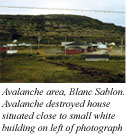Date: March 10, 1995
Location: Blanc Sablon South shore of Quebec
Easting: 491100
Northing: 5697000
Latitude: 51° 25′ 00″ N
Longitude: 57° 08′ 00″ W
Fatalities: 2
Injuries: 1
Source: Northern Pen Mar 14, 1995; Western Star Mar 11,1995
Blanc Sablon lies just over the border separating Labrador and Quebec, on the Quebec side. Although in Quebec, the 1995 Blanc Sablon avalanche is considered here because of its closeness to Labrador communities of similar physical setting, and being the most recent fatal accident in this part of Canada, the response to the disaster is instructive.
On 9-10 March 1995 a fierce winter storm battered southern Labrador and northern Newfoundland. 70 centimetres of snow fell in a short period, high winds brought down transmission lines, and roads were blocked. The town of Blanc Sablon is built around the harbour, and in recent years fifteen houses had been built at the base of a 50-60 metre cliff on the northern edge of town. These houses were sheltered from the prevailing wind, but as the wind swept over the barren plateau above the town, it carried large amounts of snow over the edge of the cliff to lie metres deep on the slope. At around 2 am the snow gave way and swept down the slope, striking the house of the Lavallee family. Tony Lavallee and his wife, Wanda, shared the house with their 17 year old son and eleven year-old daughter. Fortunately their daughter was staying at a friend’s house that night, as the avalanche tore the roof off the house, buried the three remaining family members, and carried a pick-up truck 30 metres down-slope. The house was filled with snow, and the occupants buried. Rescuers were on the scene right away, but were unable to call upon any outside resources as the roads to the community were blocked. Twenty-three local men were put to work digging out the house and, after several hours, they rescued Wanda Lavallee after hearing her shouts. She had only minor injuries, but Tony Lavallee and his son Jamie were dead.
Twenty four houses and their 69 residents were evacuated. The Army was brought in to dynamite the slopes to attempt to dislodge unstable snow. Other avalanches apparently occurred- the Western Star of March 15 reports “Snow slides have damaged homes in other nearby communities”. The only incident we’ve been able to pin down is via a verbal report of an avalanche on Capstan Island that came to rest against the wall of a house. The road remained blocked for some days; the same road had been subject to avalanches in the early 1990s, when the Provincial Emergency Measures group dynamited overhanging cornices in several locations along the Blanc Sablon – Red Bay route because of the hazard of avalanche. Shortly after the Blanc Sablon avalanche, consultants visited the site and recommended the installation of protective measures. This consisted of snow fencing along the cliff edge, with the objective of trapping the snow on the plateau and preventing build-up on the slope.
When we visited the site two years later, the snow fencing- simply stakes and plastic mesh- had already fallen into a state of disrepair. We talked to Wanda Lavalee’s brother, who still lived under the slope from which the avalanche had come from, and was one of the rescuers in 1995. He expressed a lack of trust in the measures applied and indicated that the residents wanted to re-locate from the hazardous area. They had at that point had little support from the Quebec Government. He told us of other avalanches in the same area, one of which smashed in the side of a house, and damaging a pick-up truck, and gave us his opinion that another accident in the area was inevitable. Another consultant visited the area at the request of the residents in 1998, and expressed concern at the avalanche hazard, informing the Quebec government of such.
However there was no further action until on New Year’s Eve 1999, a highly publicized avalanche struck Kangiqsualujjuaq in northern Quebec, killing nine. In the aftermath, both consultants involved at Blanc Sablon were closely involved in the inquest, and the example of Blanc Sablon was brought up repeatedly. The Coroner’s report from Kangiqsualujjuaq highlighted the lack of understanding and preparation for avalanches in Quebec and led to a re-evaluation of the situation in Blanc Sablon. The Ministry of Public Security of Quebec instituted a hazard mapping programme by the Norwegian Geotechnical Institute, covering Nunavik (7 communities in Northern Quebec) and on the Lower North Shore of St. Lawrence Estuary (7 communities in Cote-Nord). An observer was stationed in Blanc-Sablon as an avalanche forecaster for the winter 2000/2001, and in combination with two local residents kept a close eye on the snow pack. Two evacuations were ordered, although no serious avalanche occurred. In the summer of 2001 discussions were taking place with residents as to preferences with respect to relocation of vulnerable houses or purchase, and re-building. In 2002 re-location work started.

